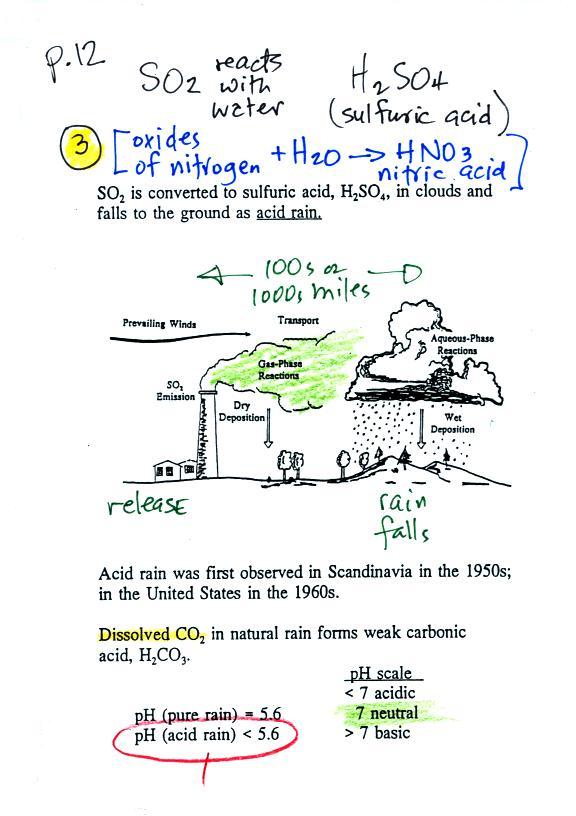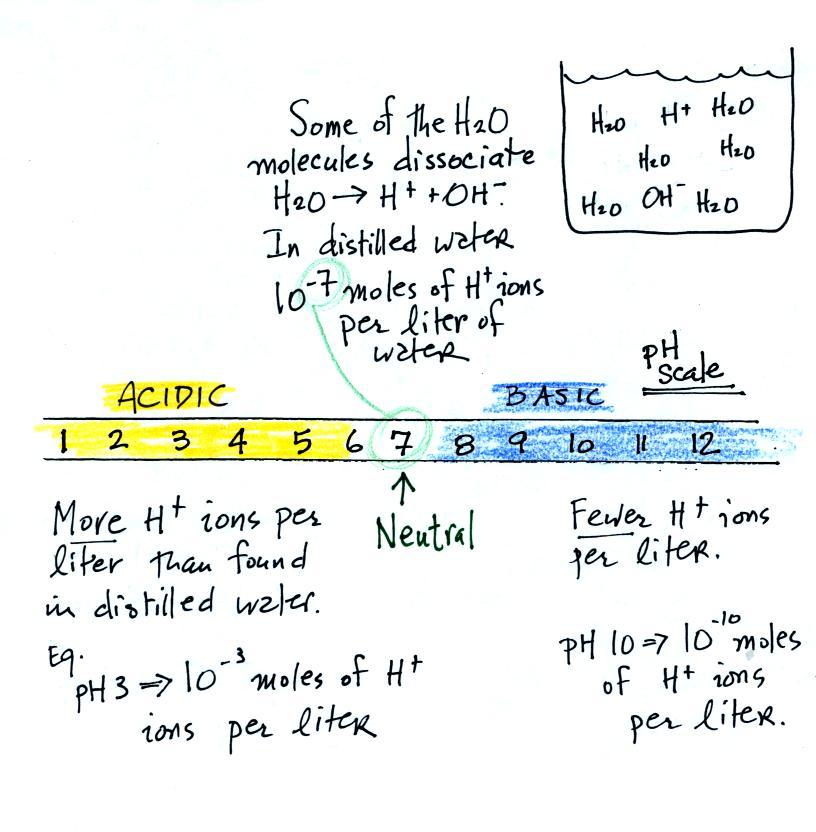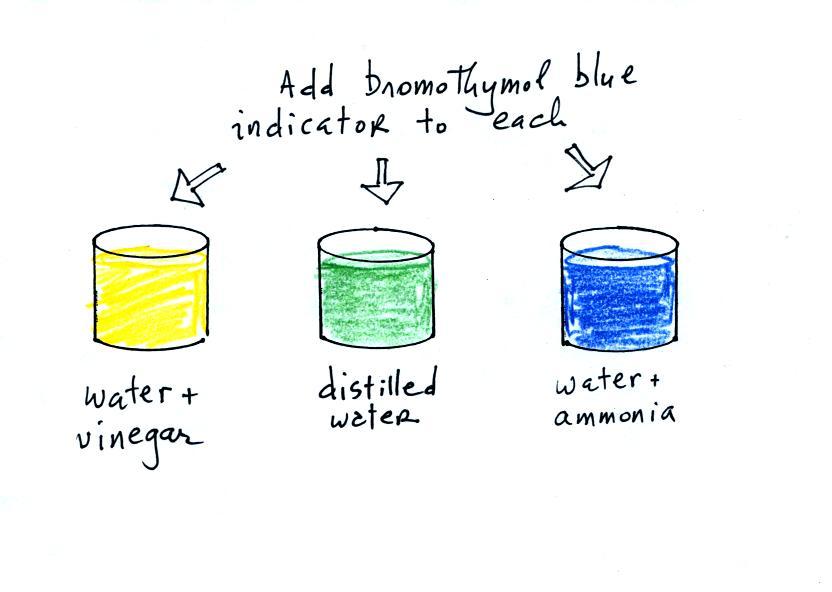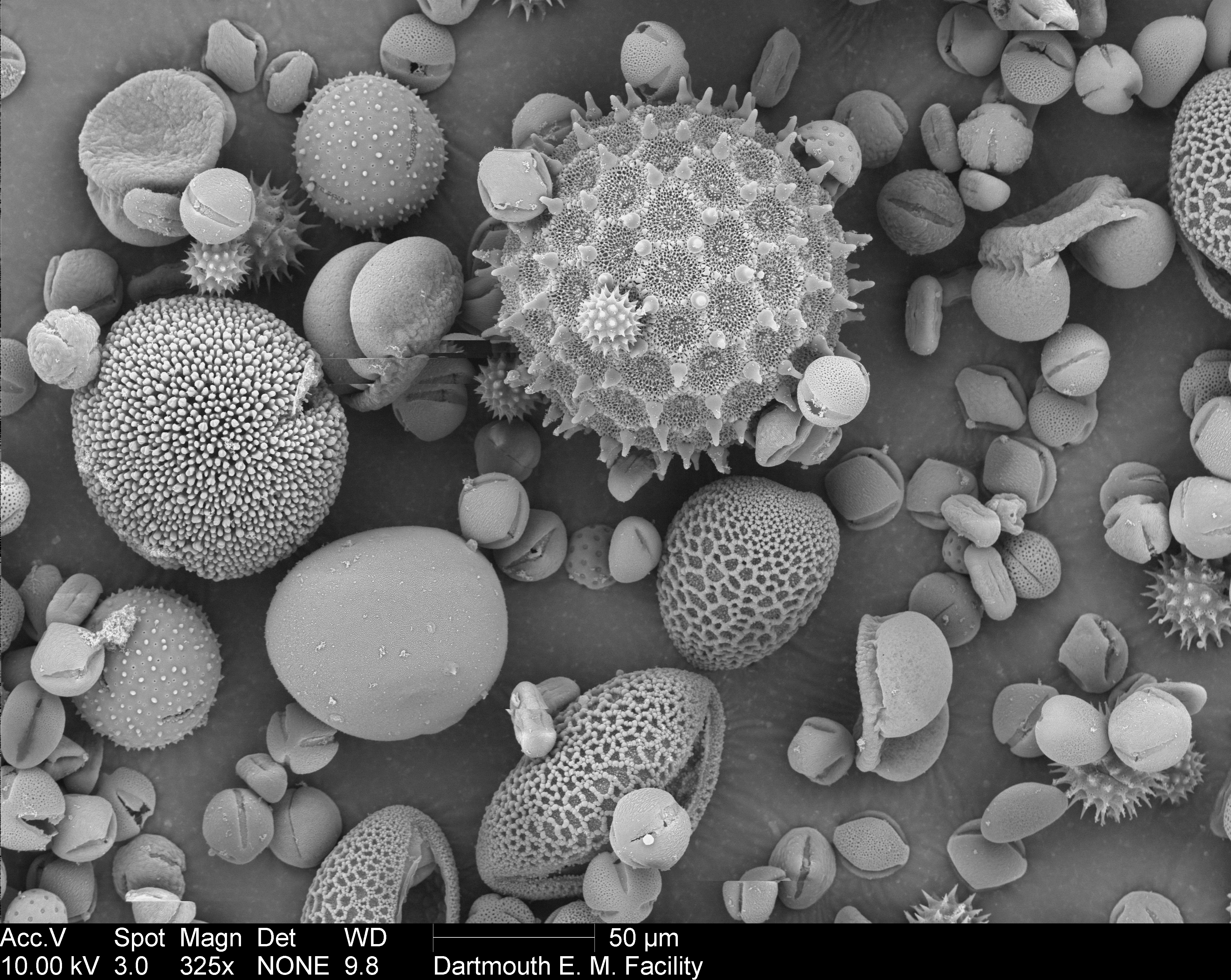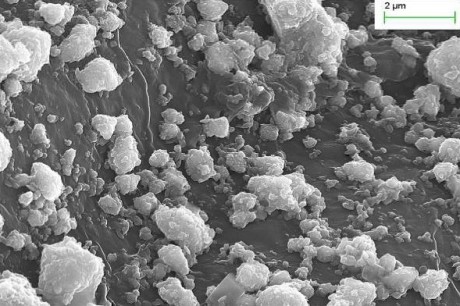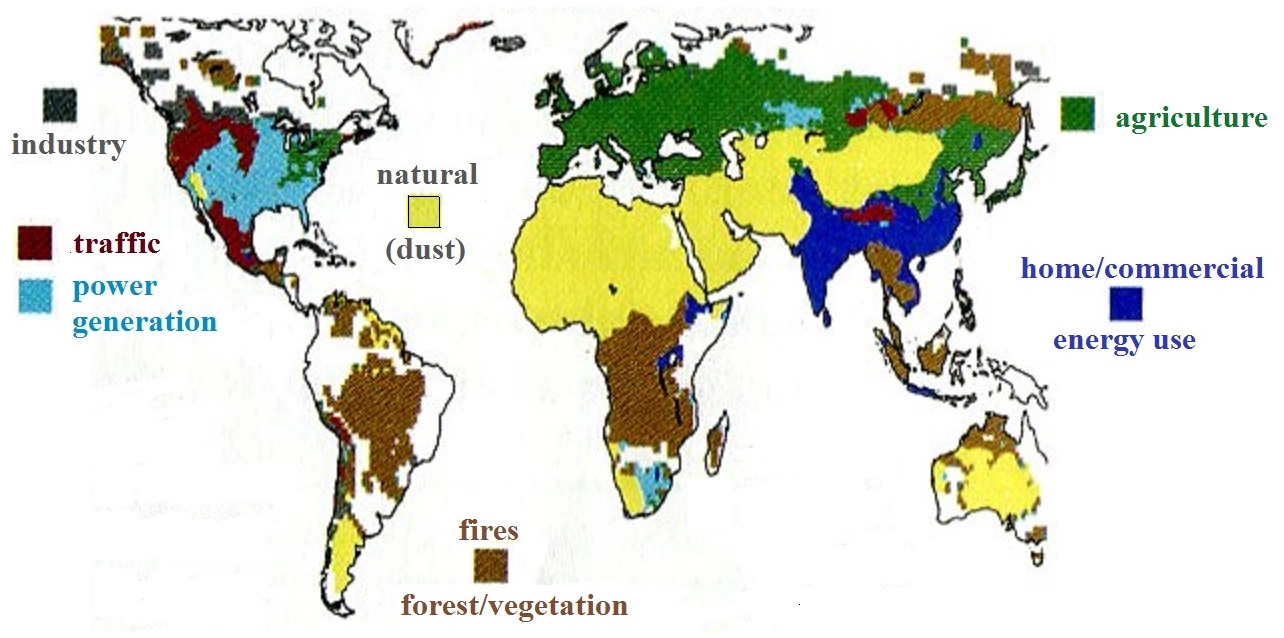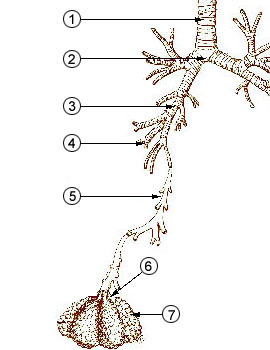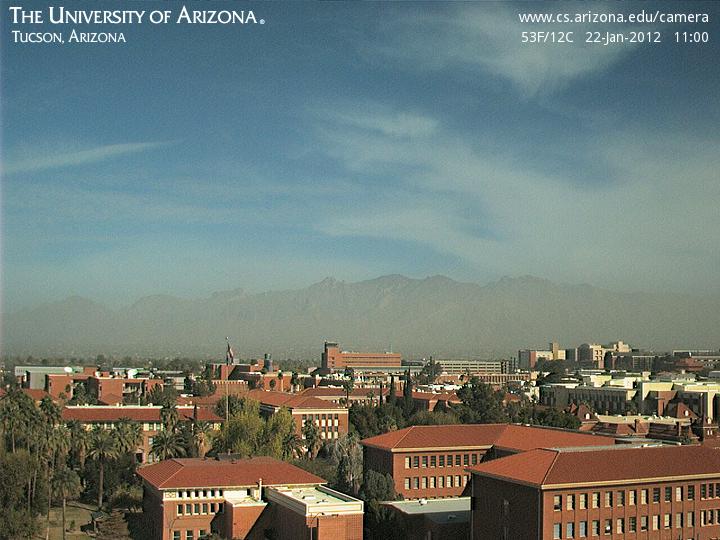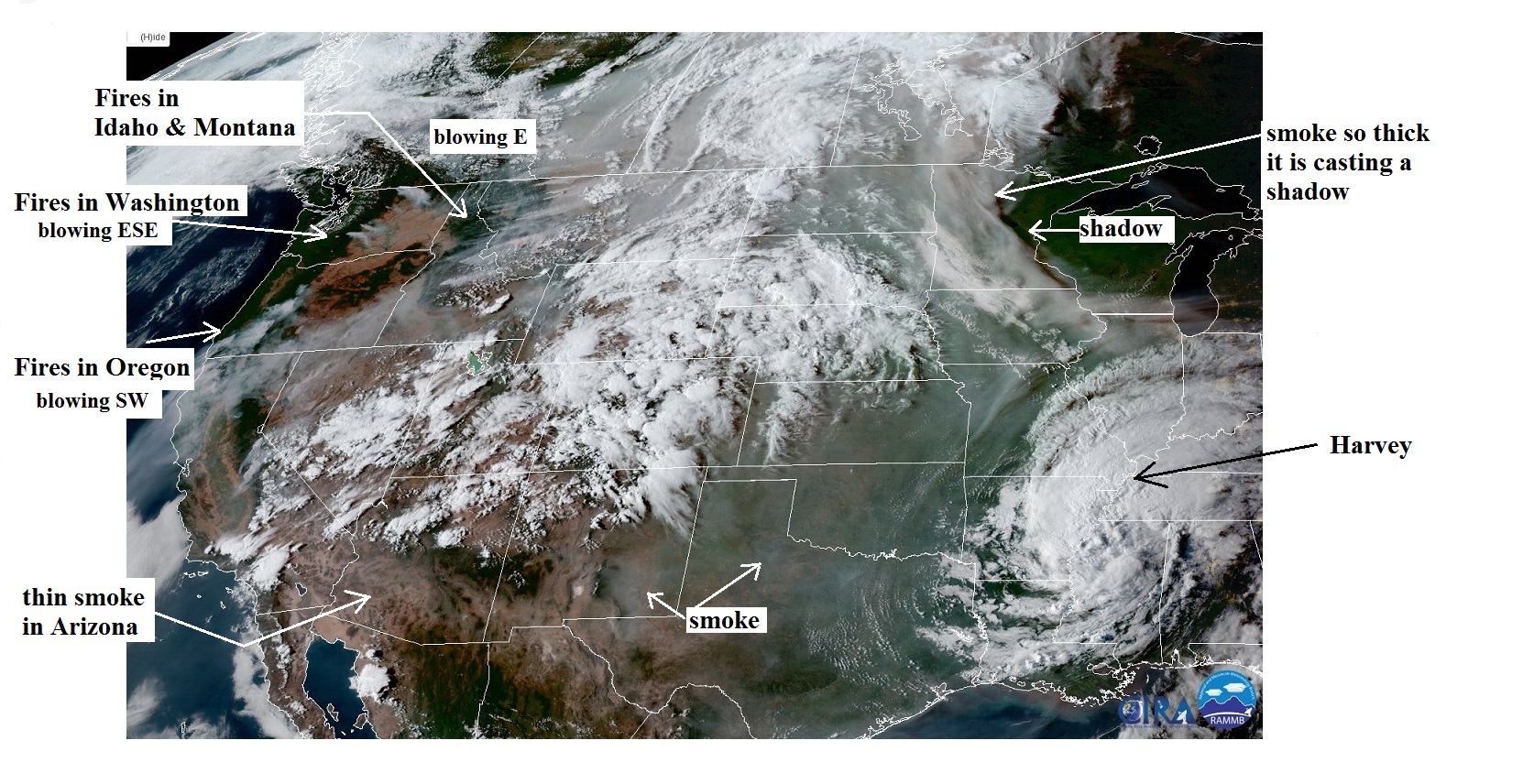Friday, Jan. 18, 2019
Rodrigo y Gabriela "Ixtapa"
(4:17), "Misty
Moses" (4:40), "Fram"
live on KEXP (4:40), "Stairway to
Heaven" (Live in Japan) (5:19), "Diablo Rojo"
(3:24)
We'll use page 12,
page 13a, and page 13c from
the ClassNotes packet in class today.
Acid rain
Sulfur
dioxide is one of the pollutants that can react with
water in clouds to form acid rain (some of the
oxides of nitrogen can also react with water to form
nitric acid). The formation and effects of
acid rain are discussed on page 12 in the
photocopied Class Notes.
Acid rain is often a problem in regions that
are 100s even 1000s of miles from the source of the sulfur
dioxide. Acid rain in Canada could come from sources in
the US, acid rain in Scandinavia came from industrialized areas
in other parts of Europe.
Note at the bottom of the figure above that natural
"pristine" rain has a pH less than 7 and is slightly
acidic. This is because the rain contains dissolved carbon
dioxide gas. For true acid rain the pH must be below
5.6. The acid rain demonstration described below and done
in class should make this point clearer.
Some of the problems associated with acid rain are
listed above.
Acid Rain Demonstration
Some common acids are listed below. In
solution the acid molecules dissociate (split) into pieces.
The presence of H+ ions is what makes these acidic.
Much of what follows is on page
13a in the ClassNotes.
And
actually it isn't enough to just have H+ ions for
something to be an acid. There are H+
ions in pure distilled water and it's not an acid. To be an
acid the H+ ion concentration must be
greater than is found in distilled water. The H+
ion concentration in distilled water is 10-7 moles
of H+ ions per liter of
water. A mole is
just a number, a very large number (6 x 1023).
It's the same idea as dozen. A dozen means you've got 12 of
something. 10-7 moles
of H+ ions per liter is
10-7 times
6 x 1023 = 6 x 1016
H+ ions per liter of water.
The pH scale
We often use the pH scale to measure acid concentration. An
H+ ion concentration of 10-7 moles/liter corresponds to
pH 7 (the pH value is computed by taking the -log10
of the H+
ion concentration). Other than remembering the pH
value of distilled water is pH7, these are all details
you don't need to worry about.
It is also possible to have fewer H+
ions in a solution than would be found in distilled water. A
solution like this is basic.
Pouring some acid into water would increase the H+ ion concentration (from 10-7moles/liter to 10-3moles/liter, perhaps as shown
in the example above). Adding a base to water will decrease
the H+ ion
concentration (from 10-7moles/liter
to 10-10moles/liter,
perhaps).
Now we can proceed with the demonstration. We will start
with three 1000 mL beakers each filled with distilled water.
Some vinegar (contains acetic acid) was added to the left beaker.
Some ammonia (a base) was added to the right beaker.
Acid/Base indicator solution
Then we added some bromothymol blue,
a color indicator solution, to all three beakers.
Bromothymol blue has the amazing property of changing color
depending on whether it is mixed with an acid (golden yellow) or a
base (deep blue).
So far we have just reviewed the pH scale and introduced
acid/base indicator solutions.
When sulfur dioxide is released into the air it reacts with the
water in clouds to produce acid rain. I really can't use SO2
in class because it's poisonous. I'll use carbon dioxide, CO2,
instead.

We added some Tucson tap water to a large 2000 mL beaker.
This represents a cloud. We added some bromothymol
blue to the tap water and it turned blue. So we know that
Tucson tap water is somewhat basic.
A few small pieces of dry ice are put into a flask. We close
the flask with a stopper. The end of a piece of tubing
connected to a spout on the flask is immersed in the tap water.
Dry ice sublimes. It turns directly from solid to ice
(ordinary ice melts and turns from solid to liquid). The
gaseous CO2 is invisible but
you can tell it is there because of the bubbles in the tap
water. Some of the CO2
dissolves as it bubbles through the water and slowly turns the
water acidic. You can tell that this is occurring because
the bromothymol blue indicator turns from deep blue to green and
eventually to yellow.
I call this a "sort of" acid rain demonstration.
That's because we haven't really produced acid rain. Air
contains carbon dioxide and the CO2 makes natural rain slightly
acidic (pH5.6 or so). To make true acid rain we would need a
different gas, something other than carbon dioxide, something that
would lower the pH below 5.6.
Ocean Acidification
While we didn't actually produce acid rain, there is concern that
increasing atmospheric concentrations of carbon dioxide will
dissolve in ocean water and lower the pH of the world's oceans
(see https://oceanservice.noaa.gov/facts/acidification.html).
This could in turn affect organisms in the ocean especially those
that make shells.
We'll finish by mentioning carbonated beverages which contain
dissolved carbon dioxide and are acidic. Soft drinks also
contain phosphoric acid which makes them even more acidic than the
dissolved carbon dioxide would do. With time the acidity of
soft drinks can damage tooth enamel.
Particulate matter (PM)
The last pollutant that we will cover is Particulate Matter
(PM). This is small solid particles or drops of liquid, not
gases, that remain suspended in the air.
Carbon monoxide (CO), O3 , and
Particulate Matter are the three main pollutants of concern in
Tucson. PM is a year round problem in Tucson.
PM pollution is split into two
groups: PM10 and PM2.5. These refer to particles with
diameters less than 10 micrometers and 2.5 micrometers,
respectively. A micrometer (µm) is one millionth of a
meter (10-6 m).
You'll find examples of metric distances ranging from kilometers
to nanometers at this
interesting site. The following is on page13c in the ClassNotes.
Sizes (in µm) of some common items are
sketched above. Don't worry about the medical terms
(bronchi, bronchioles, alveoli), you'll find an illustration and
a little more explanation in a figure further along in today's
notes.
Better than sketches are some actual photographs. Many of
these particles are so small that they are invisible to the
naked eye and need to be examined using a microscope.
Photographs of micrometer and 10s of micrometer size
objects
Electron microscope
photograph of human red blood cells..
Individual cells in this example are a little
over 5 µm in
diameter.
This is not
something you'd find in the atmosphere.
(image source: Dartmouth College
Electron Microscope Facility)
This is something that is commonly found in the air.
This is a photograph of a mixture of different types of
pollen.
The largest pollen grain comes from morning glory (I think) and
is about 100 µm in diameter
(image source: Dartmouth
College Electron Microscope Facility)
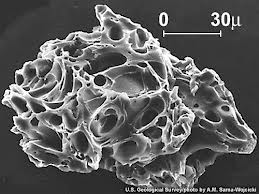
Scanning electron microscope photograph of volcanic ash
(USGS image by A.M. Sarna-Wojcick from
this source)
Airborne particulate matter
collected on the surface of a tree leaf (source).
These particles are pretty small with diameters of 1 to
2 µm.
According to the source, trees capture
appreciable amounts of particulate matter and remove it from
the air in urban areas.
Sources of particulate
matter
Particulate matter can be produced naturally (wind blown dust,
clouds above volcanic eruptions, smoke from lightning-caused
forest and brush fires). Many human activities also produce
particulates (automobile exhaust for example). Gases
sometimes react in the atmosphere to make small drops or particles
(this is what happened in the photochemical smog
demonstration). Just the smallest, weakest gust of wind is
enough to keep these small particles suspended in the atmosphere.
A recent study estimates that more than 3.2 million people die
each year across the globe because of exposure to unhealthy levels
of PM25 (click here
to see a summary and some discussion of the study and here
to see the study itself). PM25 refers to particles with
diameters of 2.5 micrometers (µm) or less;
particles this small can penetrate deeply into the lungs.
The study also attempted to determine the sources of the PM25
pollution. The figure below summarizes their
findings. Information like
this is important because you need to know what is adding
particulate matter to the air if you want to try and reduce
emissions.
CBS news has ranked the 30 cities in the world with
the most polluted air (based on World Health Organization
data for 2016) (https://www.cbsnews.com/pictures/the-most-polluted-cities-in-the-world-ranked/
). The report is interesting because there is a
photograph of each location and more detailed information
about the source of the pollution. Here is some of what
was mentioned: sandstorms, vehicle exhaust, aluminum
production, deforestation, burning waste, coal burning power
plants, oil production, leather tanning, brick factories,
chemical factories, burning tires to extract iron, steel
mills. Cities in China, India, Pakistan, Iran, and Saudi
Arabia appear multiple times in the list.
This map shows where some of the most polluted
places on earth are located (PM25 pollution) and comes from a
World Health Organization report "Exposure to ambient air
pollution from particulate matter for 2016" (http://www.who.int/airpollution/data/AAP_exposure_Apr2018_final.pdf?ua=1).
Effects of particulate matter on health
One of the main concerns with particulate
pollution is that the small particles might be a health hazard ( a
health advisory is sometimes issued during windy and dusty
conditions in Tucson).
Particles with dimensions of 10 µm
and less can be inhaled into the lungs (larger particles get
caught in the nasal passages). These inhaled particles
may be poisonous, might cause cancer, damage lung tissue, or
aggravate existing respiratory diseases. The smallest
particles can pass through the lungs and get into the blood
stream (just as oxygen does) and damage other organs in the
body.
The figure below identifies some of the parts of the human
lung. The key point is that the passageways get
smaller and smaller as you move deeper into the lungs.
The smallest particles are the most dangerous because they can
penetrate furthest into the lungs.
The 2008 Summer
Olympics were held in Beijing and there was some concern
that the polluted air would affect the athletes
performance. Chinese authorities restricted
transportation and industrial activities before and during
the games in an attempt to reduce pollutant
concentrations. Rainy weather during the games may
have done the greatest amount of good.
Clouds and precipitation are the best way of cleaning
pollutants from the air. We'll learn later in the semester
that cloud droplets form on small particles in the air called
condensation nuclei. The cloud droplets then form raindrops
and fall to the ground carrying the particles with them.
The second main concern with particulates is the
effect they may have on visibility.
Here's a view of the Catalina mountains taken from the Gould
Simpson Building on the south side of campus.
Some rainy weather that had occurred just a day to two before the
photograph was taken had done a good job of cleaning the air and
the visibility was very good.
Windy weather a few days later
stirred up a lot of dust that was carried into town.
This picture was taken the day after the windy weather.
There is still a lot of fine dust particles in the air and the
visibility is pretty bad. Again the drop in
visibility is a consequence of light scattering. This is
part of what is examined in a new
1S1P topic.
We will look at some photographs from Beijing
(if that link doesn't work try this
one) where particulate pollution can be quite severe.
Here are some pictures from Harbin,
China (October, 2013). That's about as bad as visibility can
get, visibility in some cases is just a few 10s of feet. The
problem is limited to China, here's a picture from Paris
(March, 2014) and India
(November, 2017).
During the Fall 2018 semester smoke from forest fires in
British Columbia (Canada) was blown southward into Vancouver,
Seattle, and Portland (and smaller cities in Washington and
Oregon). The air quality was for a few days as bad as you'll
find in the most polluted cities in the world. (see
"Wildfire Smoke Makes Seattle and Portland World's Dirtiest
Cities" published online by National Geographic (https://www.nationalgeographic.com/environment/2018/08/news-seattle-portland-dirtier-air-quality-than-parts-of-asia/).
|

|
These two
photograph are from the National Geographic article
referenced above.
|
Smoke from fires in California will often be seen in Tucson.
Smoke from Canada and the Pacific Northwest does also sometimes
move into our area.
Satellite photograph taken early in the Fall 2017 semester
(with the new GOES16 satellite) showing smoke from wildfires
burning in Washington, Oregon, Idaho and Montana being carried
across much of the continental US (Hurricane Harvey is also
shown). Smoke from these fires made it into
southern Arizona where, at times, it had a noticeable effect on
visibility.
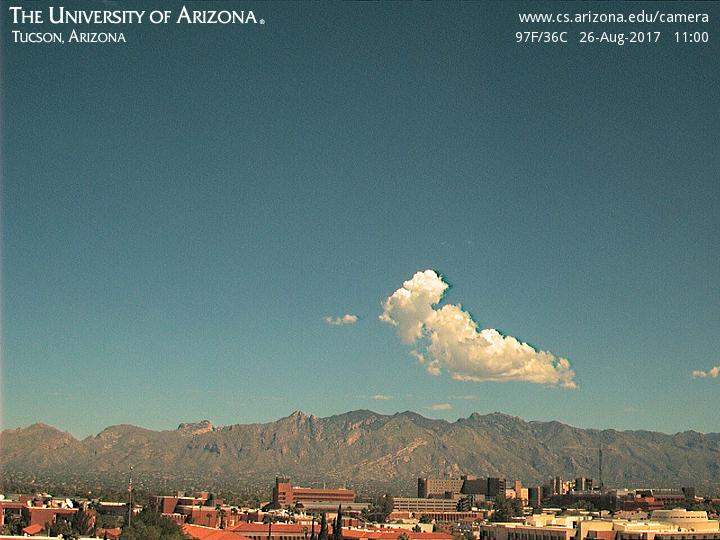
|
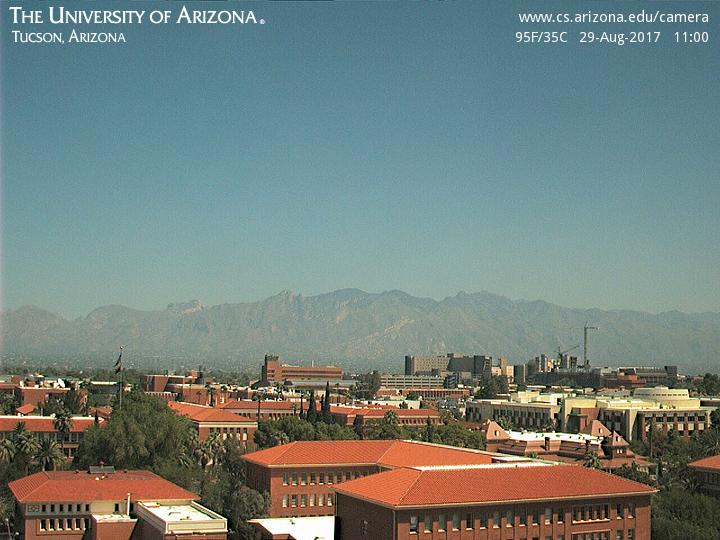
|
Photograph taken Saturday Aug. 26, 2017
when the air was free of smoke and visibility was pretty
good.
|
Photograph taken Tuesday on Aug. 29,
2017 when smoke from the fires in the Pacific northwest
was present. There has been a noticeable drop in
visibility.The camera was tilted down slightly in this
picture but the field of view is the same as the other
photograph.
|
